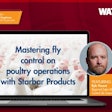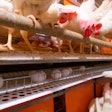Elizabeth Doughman, editor, WATT PoultryUSA and Poultry Future: Hello and welcome to WATT Poultry Chat. I'm Elizabeth Doughman, the editor of WATT PoultryUSA and Poultry Future.
This Watt Poultry Chat is brought to you by Elanco. Elanco Animal Health Incorporated is a global leader in animal health dedicated to innovating and delivering products and services to prevent and treat disease in farm animals and pets, creating value for farmers, pet owners, veterinarians, stakeholders and society as a whole.
With nearly 70 years of animal health heritage, Elanco is committed to helping customers improve the health of animals in their care, while also making a meaningful impact on local and global communities. Elanco is driven by its vision of Food and Companionship Enriching Life and Elanco Healthy Purpose – all to advance the health of animals, people, the planet and enterprise. Learn more at www.elanco.com.
Joining us today is Dr. Francene Van Sambeek, distinguished technical advisor at Elanco.
Thanks for joining us, Francene.
How has the poultry industry’s use of non-medically important antibiotics changed over the years? What factors have influenced this shift?
Dr. Francene Van Sambeek, distinguished technical advisor at Elanco: Thank you for the question.
We have definitely seen considerable shifts in production systems between no antibiotic ever (NAE) and NAIHM, which is no antibiotics important to human medicine. That’s driven by several factors, including consumer preferences on which type of production system they would like to see their product raised in. Another is an ever-increasing demand for poultry products.
And then finally, frankly, the production costs to the producers themselves in choosing which production system to use. Just in the last year, we’ve seen two major players in the poultry industry announce that they are shifting from NAE to NAIHM.
There are a couple primary reasons for that shift. One has been supply chain challenges. I think everyone is aware that we’ve all had a lot of supply chain issues in the last couple of years. When you couple that with the increasing demand for poultry products, it’s just made it very difficult for our producers.
Another aspect that we need to look at is animal welfare. In order to continue providing good animal welfare for our birds, we need additional tools in our toolbox in order to keep the birds healthy.
Then, finally, we really need to look at sustainability. In order to continue to produce poultry to the level that we’re going to need it to be to feed a growing human population, it needs to be sustainable.
Doughman: How do you work with poultry producers to establish treatment protocols for poultry diseases and conditions while ensuring judicious antibiotic use?
Van Sambeek: Our approach first and foremost has always been about the health and welfare of the animals that are in our care. We are certainly committed to promoting antibiotic stewardship. We want to combat antimicrobial resistance. But at the same time, we also want to advance the producer’s ability to provide safe affordable food to feed the world.
Having said that, we know both NAE and NAIHM programs do foster judicious use of antibiotics, mainly from the perspective of minimizing human antimicrobial resistance. NAE programs never use antibiotics and NAIHM programs only allow antibiotics that are not important to human medicine. Again, it's about reducing the potential for any cross resistance to build up.
I like to work with producers in implementing a comprehensive disease control and prevention strategy that – as long as it lives within their antibiotic policy and their particular production system – can include things like medicated feed additives or nutritional health products like prebiotics, probiotics or enzymes.
Can we utilize ionophores to control coccidiosis? Can I implement a vaccine to control Salmonella? Or do I have to go to the farm level and look at what kind of on farm management practices are we doing in order to minimize the use of our antibiotics?
I will say that what we've seen with NAIHM programs is improved feed conversion and reduced mortality rates. That would say that this particular production system would probably allow for a more sustainable and efficient use of resources in terms of feeding the world and also just, frankly, better for our environment.
Doughman: What are some examples of on-farm management practices that reduce the need for antibiotics?
Van Sambeek: Regardless of what production system that you want to utilize, there are certain strategies that are universal. By utilizing these on farm management strategies, we can actually reduce the need for antibiotics and have better chicken health, better welfare and prevent diseases.
One tool to reach out for would be to talk to your veterinarian. As a veterinarian, you are trained in epidemiology on how to look at disease, diagnose disease and figure out the best intervention strategies. When veterinarians work with producers, they provide a lot of guidance and insight on things like feeding programs to control coccidiosis, vaccines to prevent disease and will actually lay eyes onto on farm management practices that maybe could be improved.
Speaking of some of those interventions, vaccination is one tool that I do like to utilize. If I can vaccinate a bird for a common disease, then that bird is protected, he won't develop any disease and I won’t need to use antibiotics necessarily on that bird. That all goes towards sustainability.
Another practice is around biosecurity. Think about biosecurity in terms of physical protection of your poultry house. I'm trying to keep foreign invaders out. Some of those in foreign invaders may include things like rodents, darkling beetles, flies or anything that can bring a disease into my poultry house.
I'm going to look at how my litter is being managed in that poultry houses. Is it the correct depth? Is it staying the correct moisture level for bird comfort. There are times where I might recommend a full clean out of a chicken house and then spray down disinfect that house just to break a disease chain if I had a disease that was occurring in that particular house.
I'm also going to look at temperature. The baby chicks like it warmer, older birds like it cooler. I need to have the right comfort level for all those birds. We're going to control for humidity. That's usually done through ventilation by bringing in good, clean, fresh air for the birds. All those strategies go to minimizing stress.
When we talk about stress on those birds, there's handling stress. For example, if we actually have to pick them up and do something with them or just the stress of living in a chicken house. Different things that I think of when it comes to reducing stress include do I have the right amount of space for each burden? In other words, do I have the right density in that chicken house in the right areas of the chicken house? Am I ventilating right? Do I absolutely have clean water for the birds to drink at all times? Do I have a good balanced diet to provide the birds everything they need to grow and thrive?
Doughman: What monitoring practices are essential for tracking and demonstrating antibiotic stewardship?
Van Sambeek: This is what I do for a living, right? I monitor bird health and I'm looking to diagnose diseases quickly, and thereby implement treatment very quickly. That reduces the need for a lot of antibiotics.
One tool that I utilize was actually established almost three decades ago. It's called Elanco’s Health Tracking System or HTSi system. It is the world's largest database of broiler health parameters that are tracked around the globe. With the information that's in there, I can pull it out and offer producers you know insights around parameters around bird health. If I see this, then I expect to see that it can offer me an early indicator if I do have some health issues.
Because the earlier I know, the early I can implement an intervention that may help reduce the amount of antibiotics that we need to do. By utilizing the data that's in HTSi. I can hopefully help them design a really targeted, safe, effective antibiotic control program within their production system.
On one final note, I will say that by utilizing health monitoring and disease treatment options, I feel like I'm supporting sustainable production, I'm improving bird health, I’m improving bird welfare. And that's regardless of the production system that a producer may choose to utilize.
Doughman: Thank you so much for sharing these insights. For more information on the solutions discussed here today, visit Elanco Animal Health at www.elanco.com.
Thanks again, Francene, and thanks to you for tuning in.



















